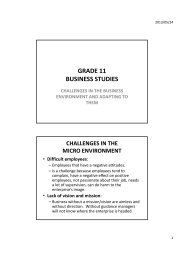Lesson 1 - SUPPORT SYSTEMS IN ANIMALS - Brebner High School
Lesson 1 - SUPPORT SYSTEMS IN ANIMALS - Brebner High School
Lesson 1 - SUPPORT SYSTEMS IN ANIMALS - Brebner High School
Create successful ePaper yourself
Turn your PDF publications into a flip-book with our unique Google optimized e-Paper software.
TYPES OF SKELETONS• Hydrostatic skeleton• Exoskeleton• EndoskeletonThe Human Skeleton can be divided into two sections:• Axial Skeleton• Appendicular Skeleton
Other tissues in the body that help to• Bone• Cartilage• Tendons• Ligaments• Joints• Skeletal musclessupport the human body
Types of skeleton• Some animals may be supported by awatery fluid inside their bodies(earthworm) – hydrostatic skeleton• Some have a hard external skeleton(crabs/locusts) – exoskeleton• Some have bone internal skeletons (frogs,birds) – endoskeleton
HYDROSTATIC SKELETONCONSISTS OF:• Fluid under pressure in a closed body compartmentMOVEMENT: These animals move by the contraction and relaxationof muscles acting against the fluid in the body compartments.<strong>ANIMALS</strong>:• Jelly-fish• Flatworms• Roundworms• Earth worms
HYDROSTATIC SKELETONENVIRONMENT:• Ideal for animals in a aquatic environmentADVANTAGES:• Provide support for crawling and burrowing• Act as cushion against shocks• Protect internal organsDISADVANTAGE• Cannot provide support for movements such as running and walkingwhere body is held of the ground
CONSISTS OF:EXOSKELETON• A hard case formed outside the body and hard outer coveringsMolluscs – shells of snails• Mainly calcium carbonate (calcereous)Arthropods – crabs, millipedes and insects• Hardened by a cuticle that is secreted by the epidermis ofthese animals• The cuticle consists mainly of chitin (polysaccharide similar tocellulose)
EXOSKELETONMOVEMENT:• Muscles are attached to the inside of the exoskeleton• The action against the exoskeleton brings about movementADVANTAGES:• It protects the animal from being attacked by predators• Prevents form dehydration of animal• Reduces damage caused by injury (rocks/logs)
EXOSKELETONDISADVANTAGES:• Cannot stretch to allow growth of the animal (thick and hard)This is overcome by the animal shedding its exoskeleton, replacing itwith a softer oneThe soft cuticle soon becomes hard againThis process is called – MOULT<strong>IN</strong>G / ECDYSIS• Reduces the movement at the jointsIt is overcome by the exoskeleton being thin and flexible at joints
ENDOSKELETONCONSISTS OF:• Hard supporting structures inside the soft tissues of ananimal• It is made up of bones• The endoskeleton of some sponges is made up of spicules ofinorganic matter or softer fibres made up of protein• In echinoderms it is made of small hard plates calledossicles ( starfishes)
ENDOSKELETONMOVEMENT:• Muscles is attached to the outside of the endoskeleton• Action of these muscles against the skeleton to workseparately bring about movementADVANTAGES:• Protects the internal organs• Bones are not continuous, it allows different parts ofthe skeleton to work separately to move• The parts of the skeleton can grow, which meansanimals with endoskeleton can grow continuously
ENDOSKELETONDISADVANTAGES• Parts on the outside of the skeleton are notoffered much protection form dehydrationand predators
Quick revision• Name 3 types of skeletal systems• The two sections of the human skeleton• 6 other tissues that helps the body with movement• Advantage of the exoskeleton• An animal with a hydrostatic skeleton





